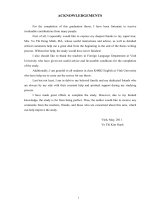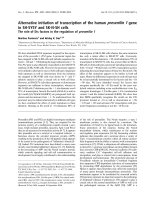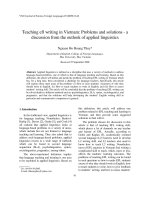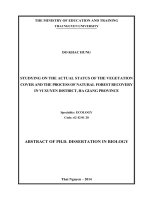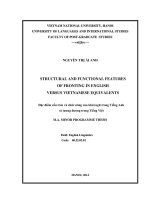Interruption in age based and gender based conversationsstudy on types, outcomes and functions = nghiên cứu về thể loại, tác động và chức năng của sự ngắt lời trong đàm thoại trên cơ sở về tuổi và giới
Bạn đang xem bản rút gọn của tài liệu. Xem và tải ngay bản đầy đủ của tài liệu tại đây (366.54 KB, 65 trang )
CHAPTER 5
ONE
====================================================
====================
VINH UNIVERSITY
Department of Foreign Languages
== ==
Lê thị thùy dung
INTERRUPTION IN Age-BASED AND
GENDER-BASED CONVERSATIONS:
STUDY ON TYPES, OUTCOMES AND
FUNCTIONS
(NGHIÊN CỨU VỀ THỂ LOẠI, TÁC ĐỘNG VÀ CHỨC NĂNG
CỦA SỰ NGẮT LỜI TRONG ĐÀM THOẠI
TRÊN CƠ SỞ VỀ TUỔI VÀ GIỚI)
GRADUATION THESIS
FIELD: LINGUISTICS
VINH, 2007
==========================================================
CHAPTER 6
ONE
====================================================
====================
VINH UNIVERSITY
Department of Foreign Languages
== ==
INTERRUPTION IN Age-BASED AND
GENDER-BASED CONVERSATIONS:
STUDY ON TYPES, OUTCOMES AND
FUNCTIONS
(NGHIÊN CỨU VỀ THỂ LOẠI, TÁC ĐỘNG VÀ CHỨC NĂNG
CỦA SỰ NGẮT LỜI TRONG ĐÀM THOẠI
TRÊN CƠ SỞ VỀ TUỔI VÀ GIỚI)
By: Lê Thị Thùy Dung – 44B1
Supervisor: Lê Thị Thúy Hà, M.A
VINH, 2007
==========================================================
CHAPTER 7
ONE
====================================================
====================
Acknowledgments
I am indebted to my supervisor Miss Le Thi Thuy Ha, M.A for her valuable counsel and
enthusiasm in the process of implementing and correcting this paper. I also owe a debt to
my close friends for their encouragements as well as belief.
I am very much grateful to my parents, who always bring me the most favorable
conditions for the process.
Special thanks to my supporters, especially those who took part in my
questionnaires and audiotape recording. And to those who put the belief on me and
assist me a lot in preparation process as well as their supports during the course of
producing this paper.
==========================================================
CHAPTER 8
ONE
====================================================
====================
ABSTRACT
Conversational interruption is one phenomenon which does not only undermine
the verbal interaction between people, but it also presents something of a paradox to
the researchers studying conversational patterns. On the one hand, interruptions are
a class of conversational behaviors that may impede the smooth flow of
information. On the other hand, social relationships, difference between ages and
genders also influence how interruptions are employed. What is more, interruptions
are difficult to define because they possess few characteristics that can be
objectively observed. Therefore, the researcher decided to put a case investigation
on behaviors of verbally conversational interruption into service.
Firstly, the researcher wished to examine theoretical approaches to interruptions,
and to frame several issues in terms of conversational analysis. Secondly, the
researcher attempted to answer whether and how interruptions change depending on
people’s age or gender. Finally, this case study hopes to contribute to the
communicative approach in general; and to conversational interrupting behaviors in
particular.
Qualitative and quantitative research methods were employed including the use
of questionnaire, naturalistic audiotape recording, the data of which were later
analyzed and discussed using procedure of data analyses
The major findings of this study support the notion that English-speaking people
interrupt cooperatively. In addition, conversational interruptions change due to
people’s age or gender. Furthermore, males and females display differences in
relative flexibility when adjusting their communication styles to different partners.
The study recommend to put further exploration to unanswered questions
regarding the theme.
==========================================================
CHAPTER 9
ONE
====================================================
====================
table of content
ACKNOWLEDGEMENTS ………………………………………………….
i
ABSTRACT ………………………………………………………………….
ii
TABLE OF CONTENT ………………………………………………………
iii
ABBREVIATION …………………………………………………………...
v
LIST OF TABLES ……………………………………………………………
vi
LIST OF FIGURES ………………………………………………………….
vii
PART A: INTRODUCTION
I.
Rationales ……………………………………………………………
1
II.
Aims of the study …………………………………………………….
2
III.
Scope of the study ……………………………………………………
2
IV.
Methods of the study …………………………………………………
3
V.
Design of the study …………………………………………………..
4
PART B: DEVELOPMENT
Chapter 1. Theoretical Preliminaries ……………………………………….
5
1.1.
Communication Theory …………………………………………......
5
1.1.1. The Concept of Communication …………………………………….
5
1.1.2. Communication Process and Elements ……………………………...
6
1.1.3. Communication Models …………………………………………….
7
1.2.
The Study of Speech Acts …………………………………………..
9
1.2.1. Foundation of Speech Acts ………………………………………….
9
1.2.2. Dialogue Acts ……………………………………………………….
11
1.2.3. Speech Acts in Conversation ………………………………………..
12
1.3.
13
Conversation Theory ……………………………………………….
1.3.1. Overview of Conversation Theory and Conversation Analysis …….
13
1.3.2. Turn-taking in Conversation ………………………………………..
15
1.3.3. Interruption in Conversation ………………………………………..
16
1.3.3.1. Concept of Conversational Interruption …………………………….
16
1.3.3.2. Conversational Interruption Affected by Politeness Strategies …….
17
==========================================================
CHAPTER 10
ONE
====================================================
====================
Chapter 2. Types, Outcomes and Functions of Interruption in Age-based and
Gender-based Conversations …………………………………………….….
19
2.1.
Types, Outcomes and Functions of Interruption ……………………..
19
2.2.
Data Analysis and Discussion ……………………………………….
23
2.2.1.
Interruption Frequencies ………………………………………….…..
23
2.2.2.
Interruption Differences by Genders ……………………………….…
27
2.2.3.
Interruption Differences by Age ……………………………………...
29
Chapter 3. Major Findings and Some Suggested Expressions for Interrupting Politely
…………………………………………………………………………
32
3.1.
Findings …………………………………………………………...…
32
3.1.1. Evaluation of Interruption ……………………………………………
32
3.1.2. Acceptability of Conversational Interruption ………………………..
23
3.1.3. Acceptability by Function ……………………………………………
33
3.2.
34
Some Suggested Expressions for Interrupting Politely ………………
PART C: CONCLUSION
I.
General Conclusion …………………………………………………..
36
II.
Limitations ……………………………………………………………
36
III.
Suggestion for Further Studies ……………………………………….
37
RERFERENCES ……………………………………………………………..
38
APPENDICES ……………………………………………………………….
41
==========================================================
CHAPTER 11
ONE
====================================================
====================
Abbreviations and signals
AI
:
Add Information
ANOVA:
Analysis of Variance
BC
:
Backchannel
BCU
:
Both Complete Utterance
CA
:
Conversational Analysis
CS
:
Challenge Speaker
CT
:
Cede Turn
CU
:
Continue Utterance
DI
:
Deep interruption
EA
:
Express Agreement
IBC
:
Interrupt Backchannel
OV
:
Overlap
RI
:
Resolve Interruption
RT
:
Retain Turn/Topic
SI
:
Silent Interruption
SIS
:
Simultaneous Initial Speech
TE
:
Timing Error
OM
:
Older Male
OF
:
Older Female
YM
:
Younger Male
YF
:
Younger Female
…
:
Uncompleted utterances or Continued utterances
==========================================================
CHAPTER 12
ONE
====================================================
====================
LIST OF TABLES
1. Result of Questionnaire
2. Total of Interruption Types, Outcomes and Functions out of 260 Interruptions
3. Total of Each Group’s Interruption
4. Means of Estimated and Actual Interruption by Questionnaire Participants
5. Total Interruption Types of Each Group
6. Total Interruption Outcomes of Each Group
7. Total Interruption Functions of Each Group
8. Number Interruption Types Recorded from 10 Tapes
9. Number Interruption Outcomes Recorded from 10 Tapes
10. Number Interruption Functions Recorded from 10 Tapes
==========================================================
CHAPTER 13
ONE
====================================================
====================
LIST OF FIGURES
1. Communication Process
2. Linear model of communication by Shanon and Weave
3. Circular model of communication by F. de Saussure
4. Conversation act types in the Traum and Hinkelman (1992) scheme
5. Interruption types, outcomes and functions
6. Mean Number of Actual and Estimated Interruptions During a 15-minute
Conversation in Four Groups
7. Mean Percentage of Interruption Types for Total Population
8. Mean Percentage of Interruption Functions for Total Population
9. Mean Percentage of Interruption Outcomes for Total Population
10. Total Interruptions in Cross-sex Groups
11. Total Interruptions by Each Group
12. Percentage of Each Group’s Interruptions
==========================================================
CHAPTER 14
ONE
====================================================
====================
PART A: INTRODUCTION
VI.
Rationales
In the course of conversations, people frequently interrupt each other. This phenomenon
presents something of a paradox to the researchers studying conversational patterns. On the
one hand, when asked how they feel about being interrupted, untrustworthy evidence
suggests that adult speakers try not to interrupt others, and that they apologize to their
conversational partners when they interrupt. On the other hand, despite this perspective on
interruptions, people do interrupt frequently, more times perhaps than they are willing to
admit.
Furthermore, interruptions are a class of conversational behaviors that may violate turntaking and impede the smooth flow of information. Social relationships, difference
between ages and genders also influence how turns are allocated and used. What is more,
interruptions are difficult to define because they possess few characteristics that can be
objectively observed; rather, their occurrence, definition, and acceptability appear to be
socially constructed by both participants and observers.
Generally, interruptions appear to play a role in the relationship between one’s age, gender,
and conversational status, in terms of how frequently one interrupts, and with which
conversational partner. In view of the higher status generally conferred by age in this
society, one would expect older people to exercise interruption rights in their conversations
with younger people. Wiens, Saslow, and Matarazzo (1966) estimated that one fifth of all
utterances are interruptions of one kind or another. Factors contributing to this variability,
such as quantity of talk, rate of speech, and type of conversation, have never been carefully
examined. Meanwhile, everyday conversation is one of the most frequent interactions in
which information is exchanged in an immense amount and in vast kinds; and interruption
is undeniably one component of that system.
==========================================================
CHAPTER 15
ONE
====================================================
====================
Therefore, an integrated conceptual framework of how interruptions function syntactically,
semantically, and pragmatically in ordinary conversations between people is needed, both
to synthesize research in these diverse areas and to address the apparent paradox of how
interruptions may facilitate communication while seeming to violate politeness rules. On
the subject of these motivations, this paper was set up to put a case investigation on
behaviors of verbally conversational interruption into service.
VII. Aims of the study
The purpose of this paper, firstly, is to examine theoretical approaches to interruptions, and
to frame several issues in terms of conversational analysis.
Secondly, the study is conducted as an attempt to explore the discrepancies in the
conceptions of conversational interruption between ages and genders.
Additionally, it is aimed at spotlighting the differences between ages and genders in
behaviors and attitudes towards their conversational partner.
Finally, this case study hopes to contribute to the communicative approach in general; and
to conversational interrupting behaviors in particular.
VIII. Scope of the study
Specifically, the study purports to address the following research questions:
The first question was whether and how interruptions change depending on people’s age or
gender.
The second question was how people judge conversational interruptions when questioned
about their perceptions of their own conversational behavior with another person.
The study is not a social investigation; rather, it is a case research. Hence, the researcher
only has the desire to specify the effects of age and gender, which are independent
variables, on the number and types of interruptions recorded during unrehearsed
conversations between dyads inside the domain of linguistics.
==========================================================
CHAPTER 16
ONE
====================================================
====================
Since all languages, regardless locations and epochs, have some characters in common.
The study spotted the light on English language as an explicit instance to discuss.
IX.
Methods of the study
In order to find the answers to the above-mentioned questions, both quantitative and
qualitative methods were employed in the forms of these following methods:
- Participants
As previously mentioned, the paper is implemented as a case study rather than
generalization. The subjects of the research hence are limited to the following groups: The
younger group (25 men and 25 women) was composed primarily of undergraduate
students who were taking 45th and 46th courses in Foreign Languages Department at Vinh
University and who were in senior year at Phan Boi Chau gifted secondary school. The
older group consisted of 25 men and 25 women recruited from College staff, state
employees, community business people, and students’ parents. The mean age of the
younger group was 19.8 years; of the older group was 47.3 years. No one had less than a
high school education.
- Data Collection
The study is conducted with the design of participant surveys, the researcher decided to
employ questionnaires and naturalistic audiotape recordings as data collection instrument.
This study employs a retrospective questionnaire of which the guiding questions were
oriented by research questions. As for audiotape recording, in order to have the factual
figure, ten conversations were recorded directly and casually to represent same age, mixed
age, same gender, and mixed gender combinations, with two individuals in a conversation.
This mode formed 10 groups, which respectively were YM1-YM1 (Group 1), YF2-YF2
(Group 2), YM3-YF3 (Group 3), OM4-OM4 (Group 4), OF5-OF5 (Group 5), OM6-OF6
(Group 6), YM7-OM7 (Group 7), YF8-OF8 (Group 8), YM9-OF9 (Group 9), OM10-YF10
(Group 10).
==========================================================
CHAPTER 17
ONE
====================================================
====================
Results of the estimative questionnaire responses and actual situations recorded were
compared and analyzed to provide the reliable and valid facts and figures.
- Data Analysis
After collecting data, the researcher summed up and drew the statements. Once the previous
methods are the getting information, this one principally deal with the results received. In
this stage, the researcher took out the understandings which were going to serve the next
chapters.
- Analysis of Variance
In general, the purpose of ANOVA in this thesis is to examine for significant
discrepancies between different groups of ages and genders. By measuring and analyzing
characters of each group and evaluating them as a whole, the research drew a quantitative
and qualitative comparison between different groups of cases or observations.
X.
Design of the study
The researcher divided the paper in to three main parts. Beginning with an introduction
about the components contained in the study, the aims, the scope, the methodology, and the
design of the paper are presented.
The second main part was Development, in which, chapter 1 explained the theoretical
preliminaries which showed understandings about the theme. Chapter 2- Types, Outcomes
and Functions of Interruption analyzed collected data and presented major remarks on the
current discussed issues. Chapter 3 was set up in attempt to contribute some expressions in
verbal interaction.
The rest of the paper served the conclusion and recommendation for further studies based on
the theme.
==========================================================
CHAPTER 18
ONE
====================================================
====================
PART B: DEVELOPMENT
CHAPTER 1. THEORETICAL PRELIMINARIES
1.1. Communication Theory
1.1.1. The Concept of Communication
Person-to-person communication is the exchange of information, ideas, and feelings
among people. Communication takes place when we transmit a message from one
person to another or to a group of people.
Fiske (1990) pointed out that: ‘Communication is one of those human activities that
everyone recognizes but few can define satisfactorily’. And the most relevant definition
of communication for present purposes is ‘social interaction through messages’ (Fiske,
1990, p.2). Scollon and Scollon (2001) refer to Gregory Bateson’s notion of
metamessages:
The anthropologist Gregory Bateson (1972) pointed out some years ago that
every communication must simultaneously communicate two messages: the basic
massage and the metamessage. The idea of the basic metamessage we are
familiar with. The metamessage is a second message, encoded and
superimposed upon the basic, which indicates how we want someone to take the
basic message. (p.77)
==========================================================
CHAPTER 19
ONE
====================================================
====================
This passage illustrates that communication is not a simple mechanical matter of
passing information from one person to another but, rather, is a complex, multilevel
event.
Therefore, communication is the complex process of interaction in transmitting
information. Communicating is to understand information and what the information are
being conveyed by others. Communication can take on many forms including gestures,
facial expressions, signs, vocalizations (including pitch and tone), in addition to speech
and written communication. In turn, a smiling, nodding face indicates that the listener is
interested in what we are saying and encourages us to continue.
1.1.2. Communication Process and Elements
It is argued that communication patterns contain various speech or communicative acts.
Consider the simple example:
Mary (talked on the phone): I won’t go to work today; this treatment keeps me
dizzy and my doctor says I should probably be reduced to part time.
Boss: Mary, this is the third day you’ve missed and your appointments keep
backing up; we have to cover for you and this is messing all of us up.
In this example, Mary has a simple message to convey - she won’t go to work today
because of dizziness. Her boss, however, was really being pressured by Mary’s
continued absences, and her late calls. In this case the boss heard hostilely from Mary
and he took no notice of her reason. Mary may not have meant this, but this is what the
boss heard.
Communications is so difficult because at each step in the process there major potential
for error. By the time a message gets from a sender to a receiver there are four basic
places where transmission errors and potential errors may occur. Also, in any
communication at least some of the ‘meaning’ lost in simple transmission of a message
from the sender to the receiver. Let us take a look at the figure below as an illustration.
encoded by
message
receiver
received
(some error
likely)
==========================================================
Message
sent
decode
(some error
likely)
CHAPTER 20
ONE
====================================================
====================
Figure 1.1. Communication Process
Stages and elements in communication process can be described as follows:
a)
The Message: A message is the component that conveys information. Words
alone do not establish the full meaning of the message. Nonverbal communications may
give clues that the receiver can use to comprehend verbal messages.
b)
Sender and Sender’s Process: The sender is the source of communication. The
sender starts the communication process by transmitting information to the receiver.
Encoding the message, whether written or oral, is a process that requires four separate
steps. The first step is to formulate the message, putting thoughts into words. The
second step consists of passing the message through psychological or internal
communication channels.
c)
Receiver and Receiver’s Process: The receiver is the element in the
communication process that interprets the meaning of the message. The receiver also
goes through an internal set of processes related to external messages. Upon obtaining
the message, the receiver decodes it through the following steps: receive, decode, filter,
and interpret. Receiving takes place when the receiver first perceives the message, either
by sight or hearing. During this process, the receiver filters the information through
their own psychological channels such as existing knowledge, attitude, beliefs,
prejudices, and perceptions. In general, successful communication occurs only when the
receiver successfully interprets the message as the sender intended.
The sender and receiver’s processes will later be illustrated by the linear model of
communication (Shannon and Weaver, 1949:7).
d)
Transmission Medium: The transmission medium is the pathway by which the
message flows. It is the vehicle that carries the message from the sender to the receiver,
and back. The medium can be electronic, written, verbal, or nonverbal.
e)
Feedback: Feedback is one of the communication elements that confirms the
message has been received and understood.
1.1.3. Communication Models
==========================================================
CHAPTER 21
ONE
====================================================
====================
There have been numbers of communication model suggested, however, we only wish
to present two prominent ones among such proposals.
a. Linear model: Shannon & Weaver (1949)
It is argued that one of the simplest and best-known communication models is that
arising from Shanon and Weaver’s (1949) classical text. This model is called Linear
Model.
Information
source
Message
Transmitter
Channel
Signal & sign
Receiver
Received signal
Destination
Message
Noise
resource
Figure 1.2. Linear model of communication by Shanon and Weaver
General characteristic feature of this model is the distinction between the mental and the
physiological / technical processes in communication.
In the illustration, signal indicates physical element and sign indicates mental one. The
message is said to be a sequence of symbols or signs, therefore this sequence stands
between source and transmitter, receiver and destination. Physical signals are
transformed into signs by a cognitive process. The communications channel is regarded
as physical or technical.
b. Circular model of communication: Ferdinand de Saussure (1990: 177)
This model can be illustrated by the cycle:
Figure 1.3. Circular model of communication by F. de Saussure
==========================================================
CHAPTER 22
ONE
====================================================
====================
This cycle presents that information flow in two directions which are connected together
by channels and tasks.
To conclude, in order to explain why and how communication takes place, models of
the flow of communication are often created. These models can serve to explain existing
communication pathways, and also to recommend communication strategies.
Communication clearly involves a set of interacting processes, in which the sender is
the one who is sending the message out; the channel is the way the message is being
sent; and the receiver is supposed to receive and use the message.
1.2. The Study of Speech Acts
The study on speech act theory originated in the field of philosophy of language. Speech
act theory was developed in the aim to give account for the functional meaning of an
utterance as not all statements reflect the classical truth-conditional semantics for
speaker’s intention. In this section we will describe an overview of the development
from Austin’s (1975) work, which was primarily concerned with the meaning of
separate utterances in context, to applied dialogue act theory.
1.2.1. Foundation of Speech Acts
Austin’s 1955 Harvard lectures, first published in 1962, is the traditional starting point
of speech act theory. Ideas from speech act theory as formulated by Austin (1975) and
Searle (1969) were used as a basis, and were further developed to capture phenomena in
verbal communication. J. L. Austin (1975) claimed that many utterances are equivalent
to actions. When someone says: ‘There he comes again’ or ‘Long time no see!’, the
utterance creates a new social or psychological reality.
A speech act is a complex unit. In his famous work, “How to do Things with Words,” J.
L. Austin outlined his theory of speech acts and the concept of performative language,
in which to say something is to do something. Austin offered an analysis of the concept
of speech acts, which distinguishes between three aspects of a speech act: locutionary,
illocutionary and perlocutionary acts as follows:
==========================================================
CHAPTER 23
ONE
====================================================
====================
a)
Locutionary acts are simply the speech acts that have taken place.
b)
Illocutionary acts are the real actions which are performed by the utterance, where
saying equals doing, as in betting, promising one's faith, welcoming and warning.
c)
Perlocutionary acts are the effects of the utterance on the listener, who accepts
the bet or pledge of marriage, is welcomed or warned.
Searle extended and refined Austin’s work on speech acts, working specifically with the
aspect of illocutionary acts. His rules were formulated on basis of four features in a
speech act: propositional content, preparatory conditions, sincerity conditions and
essential conditions.
Some linguists have attempted to classify illocutionary acts into a number of categories
or types. David Crystal, quoting J.R. Searle, gives five such categories: representatives,
directives, commissives, expressives and declarations:
a)
Commissives: here the speaker commits himself/ herself to a future course of
action, with verbs such as: guarantee, pledge, promise, swear, vow, undertake, warrant.
b)
Directives: here the speaker tries to make the hearer do something, with such
words as: ask, request, beg, invite, command, dare, challenge, insist.
c)
Declaratives: the speaker alters the external status or condition of an object or
situation, solely by making the utterance: I now pronounce you man and wife, I
sentence you to be hanged by the neck until you be dead, I name this ship...
d)
Expressives: the speaker expresses an attitude to or about a state of affairs, using
such verbs as: apologize, appreciate, congratulate, deplore, detest, regret, thank,
welcome.
e)
Representatives: here the speaker asserts a proposition to be true, using such verbs
as: affirm, believe, conclude, deny, report.
That is, when we speak we are doing one or more of the following: commiserating,
directing, declaring, expressing or asserting.
==========================================================
CHAPTER 24
ONE
====================================================
====================
Speech acts was also closer defined in a formal logic framework, such as by Searle and
Vanderveken and Searle, J. (1985). This approach, illocutionary logic, evaluates
meaning both in terms of truth conditions and success conditions.
Speech act theory and its critiques are often articulated using imagined examples, in
which the speaker’s meaning can be expressed in various modes. For instance, the
speech act which implies ‘cold weather’ can be performed as following:
==========================================================
